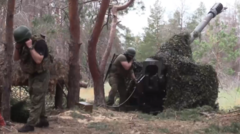The conflict in Ukraine continues to intensify as Russia attempts to establish a foothold in three key areas while facing relentless resistance from Ukrainian forces. Russian drone and missile strikes have reached alarming levels, yet ground operations have yielded only modest territorial gains; reports indicate that Russian troops managed to capture approximately 556 square kilometers (215 square miles) last month, marking their most significant advance this year—an area comparable to that of Chicago.
Russia's military strategy appears focused on disrupting supply routes for Ukrainian troops in eastern Ukraine and creating a protective buffer zone within Ukraine’s northern borders. However, the progress is reportedly slow, with current rates suggesting that it would take over 70 years to conquer the entire country. The main efforts of Russian forces are concentrated around the Sumy region to the northeast, the eastern cities of Pokrovsk and Kostyantynivka, and a newly established front west of Pokrovsk.
Despite initial movement into the Sumy region, Russian forces are encountering fierce resistance, resulting in halted advances. The motivations behind these military actions, as articulated by Russian President Vladimir Putin, include securing a buffer against ongoing incursions by Ukrainian forces into Russian territory. While limited advances have been made, significant resistance continues to impede further progression.
Military analysts note that Russia has strategically amassed approximately 111,000 troops around Pokrovsk, a critical hub they have sought to capture for over two years. On the ground, Russian tactics involve small, persistent groups of infantry who conduct continuous assaults on Ukrainian positions, a method referred to as "creeping offensives." However, this approach has resulted in substantial casualties for Russia, with estimates suggesting over 1,000 soldiers may be lost daily.
In the ongoing battle for control around Kostyantynivka and Pokrovsk, the focus remains on attempting to trap Ukrainian forces within a "cauldron," effectively encircling and forcing a retreat. While Russian forces have made claims of capturing a border village in the Kharkiv region, significant territorial gain remains unlikely without further troop reinforcement.
Although pushing advances have been reported, past efforts to progress from other fronts have stalled, suggesting limitations in Russian capabilities. Reports also indicate that while some success was noted in efforts west of Pokrovsk, such movements lack substantial strategic value and may be driven more by political narratives than military necessity.
As Russian forces employ drone technology to swiftly target Ukrainian supply lines and infrastructure, the challenges multiply for Ukraine, which has increasingly relied on robotic assistance for resource delivery amid the risks brought by drone strikes. As the situation develops, Ukrainian morale remains a critical factor, and ongoing aerial assaults aim to diminish civilian spirits and sever logistical support lines.
Ultimately, the ongoing resistance from the Ukrainian military, combined with an increasingly complicated battlefield landscape, suggests that Russian ambitions within Ukraine are fraught with obstacles, revealing the complexities of the military conflict as it evolves.
Russia's military strategy appears focused on disrupting supply routes for Ukrainian troops in eastern Ukraine and creating a protective buffer zone within Ukraine’s northern borders. However, the progress is reportedly slow, with current rates suggesting that it would take over 70 years to conquer the entire country. The main efforts of Russian forces are concentrated around the Sumy region to the northeast, the eastern cities of Pokrovsk and Kostyantynivka, and a newly established front west of Pokrovsk.
Despite initial movement into the Sumy region, Russian forces are encountering fierce resistance, resulting in halted advances. The motivations behind these military actions, as articulated by Russian President Vladimir Putin, include securing a buffer against ongoing incursions by Ukrainian forces into Russian territory. While limited advances have been made, significant resistance continues to impede further progression.
Military analysts note that Russia has strategically amassed approximately 111,000 troops around Pokrovsk, a critical hub they have sought to capture for over two years. On the ground, Russian tactics involve small, persistent groups of infantry who conduct continuous assaults on Ukrainian positions, a method referred to as "creeping offensives." However, this approach has resulted in substantial casualties for Russia, with estimates suggesting over 1,000 soldiers may be lost daily.
In the ongoing battle for control around Kostyantynivka and Pokrovsk, the focus remains on attempting to trap Ukrainian forces within a "cauldron," effectively encircling and forcing a retreat. While Russian forces have made claims of capturing a border village in the Kharkiv region, significant territorial gain remains unlikely without further troop reinforcement.
Although pushing advances have been reported, past efforts to progress from other fronts have stalled, suggesting limitations in Russian capabilities. Reports also indicate that while some success was noted in efforts west of Pokrovsk, such movements lack substantial strategic value and may be driven more by political narratives than military necessity.
As Russian forces employ drone technology to swiftly target Ukrainian supply lines and infrastructure, the challenges multiply for Ukraine, which has increasingly relied on robotic assistance for resource delivery amid the risks brought by drone strikes. As the situation develops, Ukrainian morale remains a critical factor, and ongoing aerial assaults aim to diminish civilian spirits and sever logistical support lines.
Ultimately, the ongoing resistance from the Ukrainian military, combined with an increasingly complicated battlefield landscape, suggests that Russian ambitions within Ukraine are fraught with obstacles, revealing the complexities of the military conflict as it evolves.


















